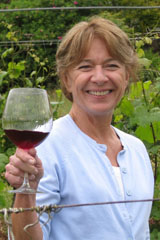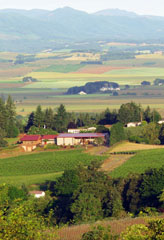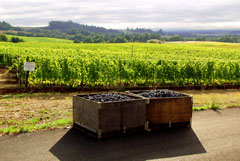Women of Oregon Wine: Pat Dudley of Bethel Heights Vineyard
By Kori ~ October 1st, 2012.
Today’s post is the first in a new series featuring the Women of Oregon Wine. For years, we have run a series featuring the Women of Washington Wine. With this new series, we are expanding to cover even more wonderful women in wine in the Pacific Northwest. In an industry once dominated by men, more and more women are joining the ranks as winery owners, vineyard owners, and winemakers. Being a woman myself, I am fascinated by these women and what they have done and continue to do. Through this series, I hope to introduce you to some of the brightest female faces in the Oregon wine industry.
 Pat Dudley and her husband Ted Castell along with Ted’s brother Terry and his wife Marilyn Webb established Bethel Heights Vineyard, located in Salem, Oregon, in 1977. For the first 30 years, Ted was responsible for managing the vineyards and Terry was the winemaker. Pat and Marilyn shared responsibilities for the business and marketing aspects of the winery. The Bethel Heights team has now expanded to include members of the second-generation, who grew up at Bethel Heights. Their current annual production is about 13,000 cases, most of which is estate grown.
Pat Dudley and her husband Ted Castell along with Ted’s brother Terry and his wife Marilyn Webb established Bethel Heights Vineyard, located in Salem, Oregon, in 1977. For the first 30 years, Ted was responsible for managing the vineyards and Terry was the winemaker. Pat and Marilyn shared responsibilities for the business and marketing aspects of the winery. The Bethel Heights team has now expanded to include members of the second-generation, who grew up at Bethel Heights. Their current annual production is about 13,000 cases, most of which is estate grown.
Recently, Pat was kind enough to take time out of her busy schedule to answer some questions for me and our Wine Peeps readers.
Highlights from Q&A with Pat Dudley:
How did you first get involved in the wine business?
My husband, Ted Casteel, and I learned to enjoy wine while working on PhD research in Europe in the early 70’s. Ted’s twin brother, Terry Casteel, and his wife, Marilyn Webb, were making wine in a garage in Seattle with a group of friends while they were in graduate school at the University of Washington. During shared family vacations, we started fantasizing about getting out of the academic rat race and living in the country, growing grapes, and making wine. We were on the lookout for an opportunity, while learning as much as we could about viticulture and winemaking. By 1977, when we saw an ad for this 75-acre property in the Eola Hills, the four of us together were ready to take the plunge. We moved to the vineyard, built two houses here, and raised our children here along with our grapevines.
What were the steps that led to where you are now?
The fundamental decision we made in the beginning was to make wine from our own grapes. Bethel Heights wine has always been all about the place where we live. We harvested our first crop in 1980, and for many years, we sold most of the fruit to other winemakers. We built a very small winery in 1984 and made our first 3,000 cases of commercial wine that year. We expanded our wine production very gradually as our vineyard matured and as we were able to expand our market. We continued to sell fruit until 1995. In 1999, we purchased the property next door and planted more vineyard, adding 20 more acres to our estate. We currently produce about 13,000 cases a year, and most of it is estate grown.
For the first 30 years, Ted was the vineyard manager, and Terry made the wine, while Marilyn and I shared responsibilities for business management and marketing. The children who grew up here went off in other directions for a while, but in 2005, two of them came back. Terry and Marilyn’s son, Ben Casteel, is now our winemaker, and Ted and my daughter, Mimi Casteel, is now our viticulturist and general manager. Both have a great respect for the vineyard where they grew up, especially the old legacy blocks that are as old as they are. And, both have a determination to take Bethel Heights to the next level, which their parents are finding quite invigorating.
 Has being a woman been an advantage or a disadvantage in your wine journey?
Has being a woman been an advantage or a disadvantage in your wine journey?
I don’t think in my case it has been either an advantage or a disadvantage because our business has always been a family affair, with all four of us really acting as a team and all four of us equally involved in the business and equally active in industry activities. I never actually tried to make my way independently in the wine world; Bethel Heights always gave me a de facto position.
What advice do you have for a woman wanting to get involved in the wine business today?
First, get a good liberal education. There is no substitute for being able to think broadly and deeply and being able to read and write extremely well. This is what gives you the flexibility to take on whatever challenge comes along. Next, try to get some experience in all aspects of the business from production through marketing, no matter where you want to end up. I regret to this day that I did not pay enough attention to winemaking basics in the beginning; I was too exclusively interested in viticulture.
What are your thoughts about the Oregon wine industry, in general? Â
At least as far as the Willamette Valley goes, I think it is built on a rock solid foundation: the perfect match of grape variety to climate. Beyond that, we’ve had the great good fortune to belong to a wonderfully supportive, collaborative community of like-minded people who really do believe that we’re stronger when we act together. It has been the source of our collective success since the beginning, and we are delighted to see it continuing in the second generation.
In recent years the Oregon wine industry has grown at a fairly rapid rate. Do you expect that trend to continue? Â
Well, it has slowed down a lot with the recession, not surprisingly. I suppose if the economy ever settles into a more predictable mode again, the industry will start growing again. There is certainly plenty of good potential vineyard land available, but it takes a lot more money to get started now than it did when we started out, and the market for premium Pinot Noir is not as sweet right now as it was in the Sideways moment. Frankly, I think our entire economy was growing at an unsustainable rate for too many years, so one can only hope we don’t get that overheated again any time soon. It’s time to recalibrate.
In most parts of the wine world, when someone says “Oregon wineâ€, the first thing that comes to mind is Pinot Noir. Do you think that it has been an advantage or a disadvantage for the Oregon wine industry to be so closely linked to a single variety? Â
Absolutely an advantage. Pinot Noir is in a class by itself as far as wine varieties go, and we are lucky enough to be in one of the few places in the entire world where Pinot Noir grows happily. Great Pinot Noir will never be in oversupply.
 What do you think will be the “next big thing†in Oregon wine to capture the attention of wine lovers outside the state? Â
What do you think will be the “next big thing†in Oregon wine to capture the attention of wine lovers outside the state? Â
2010 Pinot Noir! Every new vintage here is the next best thing. Every vintage in the Willamette Valley brings delightful surprises. 2010 was cool and late. The wines are supremely elegant, especially compared to the blockbuster 2009’s.
What is your vision for the future of Bethel Heights Vineyard?
As I mentioned earlier, I am very excited about the second generation taking the helm. I see Bethel Heights continuing to be the “family farm†for our whole extended family, the place everyone comes back to for family reunions for generations to come, with a cellar full of many vintages made by successive generations in this unique place.
—
Many thanks to Pat for sharing her story and thoughts with us. I wish her, Ted, Terry, Marilyn, and their entire family all the best and will continue to follow their work and Bethel Heights Vineyard with great interest, and I hope that you will too.
(Photos from Bethel Heights Vineyard)
Filed under: American Wine, Interview, Oregon Wine, Women of Oregon Wine

 Wine Peeps is an independent wine blog dedicated to helping you get the most bang for your buck in wine. We do this through blind tastings of wine from around the world and calculations of
Wine Peeps is an independent wine blog dedicated to helping you get the most bang for your buck in wine. We do this through blind tastings of wine from around the world and calculations of 










